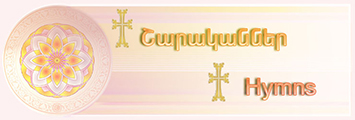Tabernacle Feasts
The five greatest feasts of the Armenian Church are the tabernacle feasts. These feasts are called tabernacle feast because special tents called tabernacles, were set up in the fields for their observance. Each feast is preceded by a period of fasting and followed by a day of remembrance of the dead.
Christmas (Dznound, Astvatsahaytnutyun, Theophany) January 6. Christmas commemorates the birth and Baptism of Christ. The Armenia Church along with other ancient Eastern Churches celebrate Christmas on January 6.
Easter (Zatik, Harutyun) (between March 22 and April 25, First Sunday after the first full moon after the vernal equinox (March 21)). Easter commemorates the Resurrection of Christ and includes all the feasts related to Easter, including Palm Sunday, the Last Supper on Holy Thursday, the Crucifixion on Good Friday.
Transfiguration (Vardavar, Aylakerpum) (14 weeks after Easter). The Transfiguration commemorates the Jesus' transfiguration, when he was visibly glorified in the presence of his three disciples, Peter, James and John. According to the Gospels (Matt. 17:1-8, Mark 9:1-10, Luke 9:28-36), while Jesus was on Mount Tabor, Moses and the prophet Elijah appeared beside Jesus and all three were engulfed in heavenly light. This transfiguration was witnessed by the disciples Simon-Peter, James and John Zebedee, who erected tabernacles and were surrounded by a cloud and a voice told them, "This is my Son and I have chosen him. Listen to Him."
Assumption (Astvatsatsin, Verapokhum, Khaghoghorhnek Blessing of the Grapes) (Sunday closest to August 15, August 12-18). The Assumption commemorates the taking of Mary, the Holy Mother of God, to heaven after her death, 15 years after Jesus' death.
Exaltation of the Holy Cross (Khachverats) (Sunday closest to September 14). The recovery of the Cross from the Persians and its return to Jerusalem, as a symbol of triumph, ca. 630 by the Emperor Heraclius of Byzantium, whose father, according to tradition, was Armenian.
